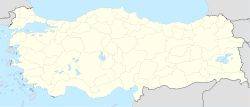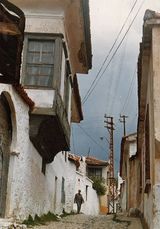- Muğla
-
This article is about the provincial capital. For the province, see Muğla province.
Muğla — Province center, District — Location of Muğla district within Muğla Province. Location of Muğla district within Muğla Province. Coordinates: 37°22′N 28°36′E / 37.367°N 28.6°ECoordinates: 37°22′N 28°36′E / 37.367°N 28.6°E Country  Turkey
TurkeyRegion Aegean Province Muğla First cited In 2nd century BC under the indigenous name of Mobolla during its passage from a Carian federation linked with Taba (Tavas) to Rhodian domination. Lycian or Carian to Menteşe Turkish period (14th century) Cited as Mobolla with an intermediate form Mogolla attested later. Menteşe Turkish period (13th century) to the present Cited as Muğla and a Menteşe urban center, after 1426 center of an Ottoman vilayet, after 1923 center of the homonymous province under the Turkish Republic Municipalities 5 Government – Mayor Osman Gürün (CHP) – Prefect Area – Total 1,582 km2 (610.8 sq mi) Elevation 660 m (2,165 ft) Population (2007)[1] – Total 94,207 (district) – Density 59.6/km2 (154.4/sq mi) – center 61,550 Time zone EET (UTC+3) – Summer (DST) EEST (UTC+3) Postal code Area code(s) (+90) 252 Licence plate 48 Website Muğla Municipality
Governorship of MuğlaMuğla (pronounced [muʝɫa]) is a city in south-western Turkey. It is the center of the district the same name, as well as of Muğla Province, which stretches along Turkey´s Aegean coast. Muğla center is situated inland at an altitude of 660 m and lies at a distance of about 30 km (19 mi) from the nearest seacoast in the Gulf of Gökova to its south-west. Muğla district area neighbors the district areas of Milas, Yatağan and Kavaklıdere to its north by north-west and those of Ula and Köyceğiz, all of whom are depending districts. Muğla is the administrative capital of a province that incorporates internationally well-known and popular tourist resorts such as Bodrum, Marmaris and Fethiye.
The district area's physical features are determined by several pot-shaped high plains abbreviated by mountains, of which the largest is the one where the city of Muğla is located and which is called under the same name (Muğla Plain). It is surrounded by slopes denuded of soil, paved with calcerous formations and a scrub cover which gives the immediate vicinity of Muğla a barren look uncharacteristic for its region. Arable land is restricted to valley bottoms.
A relatively small city of 61,550 (2009 estimates) and often overlooked by visitors to near-by coastal resorts, Muğla has received a new boost with the foundation of Muğla University in the 1990s. Today, the university brings together a student community of 16,000 and, added by its academia and staff, it played a key role in bringing movement to the city and in opening it to the outside world. Its former profile of a predominantly rural, difficult to access, isolated and underpopulated region enclosed with a rugged mountainous complex is now coming to an end. Also in recent years, a major program of restoration of the city's architectural heritage has enhanced local tourism. The city remains an orderly, compact and leafy provincial center which could keep its old neighborhoods without surrendering to a boom in concrete constructions and displays a progressist mind as exemplified by the pride still expressed on having had Turkey's first female provincial governor in the 1990s, Ms. Lale Aytaman. Nevertheless, Muğla still lacks sizeable manufacturing and processing centers and relies on trades, crafts, services, tourism and agriculture in its economy.
Contents
History
- See Muğla Province and Caria for more information on the history of the area as a whole
In ancient times, Muğla was apparently a rather insignificant settlement halfway on the passage between the Carian cities of Idrias (later Stratonicea) to the north and Idyma (modern Akyaka) to the southwest on the coast. The indigenous name Mobolla, which survives with little change, appears for the first time in the beginning of the 2nd century BC at the time of its region's passage from what was apparently an eastern Carian federation linked with Taba (modern Tavas) and other cities to Rhodian domination. Mobolla was part of the Rhodian Peraea on a firm basis as of 167 BC until at least the 2nd century AD. The Rhodian territory started here and while region was subject to Rhodes, it was not incorporated in the Rhodian state.
There are almost no ruins to reveal the history of the settlement of Mobolla. On the high hill to the north of the city, a few ancient remains indicate that it was the site of an acropolis. A handful of inscriptions were unearthed within the city itself and they date back to the 2nd century BC..
Turkish-era Muğla also remained a minor site in the beginning despite having been captured relatively early for western Anatolia in the course of the 13th century. The local ruling dynasty of Menteşe had their capital in Milas. Muğla acquired regional importance after it replaced Milas as the seat of the subprovince (sanjak) under the Ottoman Empire in 1420. The sanjak kept the name Menteşe until the Republican Era, when it was renamed Muğla after its seat of government.
Climate
Muğla has a Mediterranean Climate. It is characterised by long, hot and dry summers with cool and wet winters.
Climate data for Muğla Month Jan Feb Mar Apr May Jun Jul Aug Sep Oct Nov Dec Year Average high °C (°F) 10.1
(50.2)10.7
(51.3)14.3
(57.7)18.6
(65.5)24.4
(75.9)29.8
(85.6)33.5
(92.3)33.4
(92.1)29.2
(84.6)23.3
(73.9)16.2
(61.2)11.2
(52.2)21.23
(70.21)Average low °C (°F) 1.5
(34.7)1.6
(34.9)3.5
(38.3)7.0
(44.6)11.4
(52.5)16.3
(61.3)19.8
(67.6)19.6
(67.3)15.1
(59.2)10.3
(50.5)5.4
(41.7)3.0
(37.4)9.54
(49.18)Precipitation mm (inches) 216.4
(8.52)170.7
(6.72)119.2
(4.693)71.5
(2.815)49.5
(1.949)26.6
(1.047)10.3
(0.406)11.3
(0.445)21.2
(0.835)62.6
(2.465)160.7
(6.327)237.8
(9.362)1,157.8
(45.583)% humidity 76 76 72 67 61 52 45 47 50 62 73 80 63.4 Avg. rainy days 13.2 12.3 10.6 9.9 7.6 3.5 1.8 1.5 2.7 5.9 9.8 13.9 92.7 Sunshine hours 127.1 140 189.1 213 263.5 306 331.7 331.7 288 229.4 153 114.7 2,687.2 Source no. 1: Devlet Meteoroloji İşleri Genel Müdürlüğü [2] Source no. 2: Weatherbase [3] Places of interest
Although it is close to major resorts, Muğla has only recently begun to attract visitors. Sights of interest in the city include:
- Vakıflar Hamam - a still operating Turkish bath which dates back to 1258.
- Great Mosque of Muğla (Ulu Cami) - large mosque built in 1344 by the Beys of Menteşe.
- Kurşunlu Cami - large mosque built in 1495
- Konakaltı Han and Yağcılar Han - restored 18th century caravanserais, the first used as an art gallery and facing Muğla Museum, and the second used for more commercial purposes.
- the Ottoman Empire-era bazaar (Arasta) - marked by a clock tower built by a Greek craftsman named Filivari Usta in 1895,
- Muğla City Museum has a good collection of archaeological and ethnographical artefacts, as well as 9 million years old animal and plant fossiles recently discovered in Kaklıcatepe nearby.
The old quarter of Muğla - on the slopes and around Saburhane Square (Meydanı), consisting of about four hundred registered old houses dating from the 18th and 19th centuries, many of which are restored. These houses are mainly in the Turkish/Ottoman style, characterized by hayat ("courtyard") sections accessed through double-shuttered doors called kuzulu kapı ("lamb doors") and dotted with chimneys typical of Muğla. But there are also a number of "Greek" houses. The differences between the two types of houses may have as much to do with the extent to which wood or stone were used in their architecture, and whether they were arranged in intraverted or extraverted styles, as with who inhabited them previously.
Local students tend to hang out in open air cafés along the İzmir highway or in the caravanserai or in Sanat Evi ("Art House"), an Ottoman style residence that has been turned into a café/art gallery exhibiting principally wood carvings.
Politics
Muğla's political color has traditionally been center-left. In Turkey's 2004 local elections, Dr. Osman Gürün (CHP) was re-elected, increasing his votes to 43,28 %, aided in this by the abrupt virtual collapse of the other center-left party the DSP. The 2004 elections were the seventh successive victory for the center-left candidates in the Muğla municipality. Turkey's incumbent AKP and the traditional center-right DYP have each obtained (24,5-24.75 %). In 2009 communal elections, MHP made a significant leap in votes and reached %24,2 of casts. CHP had collected almost half of the votes at %46.
Sports
The local football club, Muğlaspor currently apply their trade in the third tier of the Turkish football pyramid.
Notable people from Muğla
- Şahidi İbrahim Dede - 15th-16th century Sufi poet.
- Zihni Derin - 20th century agronomist and agriculturalist who pioneered tea production in Turkey
- Nail Çakırhan - 20th century poet and architect
Due to the particularity of its location, commanding a large part of Anatolia's southwestern coast and a number of busy district centers, Muğla is also notable by the large number of people who, short of being natives in the strict sense, had associations of one sort or another with the city, including among its small Greek minority until the 1923 Population exchange between Greece and Turkey.[4] Among these can be cited;
- Arms trading tycoon Basil Zaharoff, whose family were actually Greeks of the Ottomnan capital but who was born in Muğla in 1849.
- Mining and poultry magnate Yavuz Sıtkı Koçman (d. 2002) who contributed an important part of his fortune to building the university in the 1990s.
- The French actress of Greek descent Anna Mouglalis, as attested by her name, can trace her roots to the city.
Sources
- George Ewart Bean (1989). Turkey beyond the Meander ISBN 978-0-7195-4663-1. John Murray Publishers Ltd, London.
See also
Footnotes
- ^ Muğla nüfus sayımı sonuçları
- ^ İl ve İlçelerimize Ait İstatistiki Veriler- Meteoroloji Genel Müdürlüğü
- ^ http://www.weatherbase.com/weather/weatherall.php3?s=29271&refer=&units=us&cityname=Mugla-Turkey
- ^ According to 1912 figures, the Sanjak of Menteşe (Muğla) had a total population of 42,000, in which 1,500-4,000 according to varying sources, were Greeks (S. Anagiostopoulou (1997) and G. Sotiriadis (1918) for the demographic data). Most Greeks residing in the subprovince lived in the city of Muğla, pp. 55, totalling slightly more than 1,000 in number. Peter Benedict (1974). Ula : An Anatolian Town ISBN 978-90-04-03882-0. Brill Publishers.
External links

 Muğla in Muğla Province (in the Aegean region) of Turkey
Muğla in Muğla Province (in the Aegean region) of TurkeyUrban districts Muğla
Rural districts RegionsAegean Black Sea Central Anatolia Eastern Anatolia Marmara Mediterranean Southeastern Anatolia Categories:- Districts of Muğla
- Muğla Province
- Cities in Turkey
- Aegean Region
- Muğla
- Caria
- Ancient Greek sites in Turkey
- Populated places in Muğla Province
Wikimedia Foundation. 2010.





